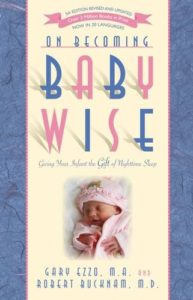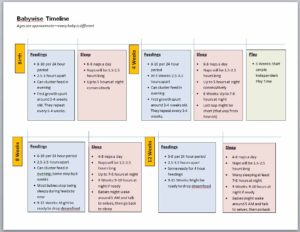
I know for me and my household, getting the baby to sleep through the night as early as possible is KEY to everyone being happy and content on a daily basis. That being said, I have incorporated the book On Becoming Babywise into my parenting style. For the first 2 kiddos, it worked like a charm and they were both sleeping through the night no later than 9 weeks. You heard me right…no later than 9 weeks!!! It was FANTASTIC! It takes work and dedication but by following the “rules” laid out for you, you too can have a sleeping baby in no time. With my third, we are starting the implementation process this week and I plan on documenting how it goes throughout the sleeping journey.
Sometimes when we start something new, it’s difficult to know where exactly to begin and what exactly to expect. After reading On Becoming Babywise, my husband and I knew we wanted to sleep-train using Babywise, but translating written content into real life application involves a learning curve. I wanted to give you a run-down of what this process looks like.
1. Mentally prepare before the baby is born.
As a basic first step, read On Becoming Babywise as a couple and then talk about it together. When both parents are on board, everything runs more smoothly. Here are a few things I try to remind myself, when sleep-training…
- Babies will likely start sleeping longer stretches around 3-4 months.
- Troubleshooting at various points throughout the process is normal!
- Stay committed! You will see results!
- It is always okay to make modifications!
- Set the foundation! It will have positive lasting effects in the future months and years to come!
2. Start the basics at birth.
If you need to get acclimated for a few weeks before starting the basics that is 100% okay. Don’t stress! I was a nervous, anxious wreck that I wasn’t doing everything right from the beginning. It was a total waste of energy. The first few weeks won’t make or break the future. Start as soon as you mentally feel ready.
Set a morning wake up time and a bedtime. We want to set the baby’s internal clock to encourage consistent night time sleep. It’s most common to see a 7 am wake time and a 7 pm bedtime. In a newborn, you may have a slightly later bedtime for a short while to help fit in enough feedings. After a few months, bedtime can usually be moved to an earlier time.
Create a basic routine for your day. Using the wake, eat, sleep cycle, fill in your approximate times for feedings and naps. In the beginning we are all likely on an approximate 2.5 hour to 3 hour schedule. If you set a wake time and a bedtime, it’s easy to fill in the middle.
Start a pre-sleep ritual. A 5 minute pre-nap routine and a 30 minute before-bedtime routine is simple, practical and easy to use. A pre-nap ritual could include swaddling the baby, sitting for a bit, singing a short song, and saying your sleepy words (e.g. I love you. I hope you have a good sleep, and I will see you when you wake up). A before-bedtime routine could include a bath, soft music, reading a short story, nursing the baby, and saying your sleepy words. Do what works for you.
Don’t let naps get too long. Sleeping too long of a stretch during the day can rob nighttime sleep. Limit naps to approximately 2 hours during the day. If the baby sleeps past the two hour mark, it is absolutely okay to wake a sleeping baby. If you feel the baby truly needs longer naps, feel free to make adjustments and increase the nap limit to 2.5 hours.
Swaddle. From birth to about age four to five months, a baby possesses the startle reflex, in which the baby actually feels as if he is falling. The sensation of falling causes jerking movements, and the baby will inadvertently wake up. Keeping a tight swaddle prevents babies from startling awake, helping the baby sleep both better and longer.
Create a good sleep environment. Dimming the room by closing the blinds or curtains is great a great place to start. Using a small fan or white noise machine in the room is also helpful if your baby struggles to sleep through noise.
Encourage full feedings. When the baby eats a full meal, it will be easier to make it to the next feeding time. It is also easier for the baby to complete a full nap without waking early due to hunger.
Dreamfeed. Before going to bed, we can pick the baby up without really waking him and give an additional feeding. The dream feed helps prevent the baby from waking up shortly after we moms go to sleep.
3. Start laying the baby down awake…
When you lay the baby down awake, there will likely be some crying involved. Crying should be in no way extreme or long in duration. If your baby is struggling to fall asleep on his own, reassurance and support from mom or dad is really important. Allowing your baby to become very drowsy, yet slightly awake can really help with this process. If your baby is fussing for a long time, it can frequently be attributed to overtired or over-stimulation but there are many other disruptions that may be the culprit.
It is common for Babywise parents to start somewhere in the birth to 2 month window. It isn’t necessary to choose before the baby is born; it’s okay to get to know the baby and start when you instinctively think it is best. We started at age 3.5 weeks.
Lay the baby down for a nap after meeting all of the baby’s needs (fed, changed, etc) and the baby has been awake for a bit and the baby is showing sleepy cues (i.e. a yawn, a fuss, or an eye rub). When my daughter was getting close to a nap, I would keep stimulation to a minimum. Sometimes I would just walk her around the house for a bit and hum softly.
Then I would take her to her room, close the curtains, place her in her sleep sack or swaddle, turn on the white noise, and hold her for a few minutes. Next, I would say her Sleepy Words…something like ‘I love you. I hope you have a good sleep. I’ll see you when you wake up.’ Then we would pray.
And finally, I would lay her down. On average, she would fuss from 0-10 minutes. Of course, some days she didn’t fuss at all and some days she fussed for longer. We stayed very, very consistent. And by 3 months there was no fussing before naps or bedtime at all, unless something was off such as travel or overtired or overstimulated.
You can also try ‘shush-pat’: I originally tried ‘Shush-pat’ method from the Baby Whisperer book. After preparing the baby for sleep, you can make a gentle shushing sound and pat your baby’s back while you are holding him. Then lay your baby down drowsy, but awake and continue shushing and pat his side or chest until he falls asleep. This is a great method to help your baby get used the crib.
4. Consistency is key.
This is so important. I stayed home for a few short weeks once I started to set the foundation and provide my daughter the opportunity to get the hang of it very quickly. This also prevents the baby from falling asleep in your arms or the car when you are out, allowing us to stay on schedule at least until the foundation is set. After the initial two week period, I got a little more adventurous with leaving the house. We can’t stay inside forever, right?!
Beginning to sleep-train using Babywise does involve some work, but the fruits of your labor will undoubtedly pay off. She started sleeping 10+ hours through the night at around two and a half months, which at the time, was a much welcomed change. I hemmed and hawed for a little while about letting go of the night feedings. All babies will regress at some point (i.e. teething, growth spurts, and beyond), and you will be awake during the night feeding the baby once again. In the meantime, it’s okay to give yourself permission to get some much needed rest.




0 Comments